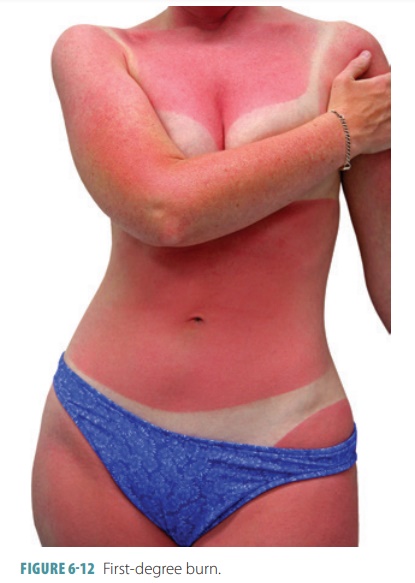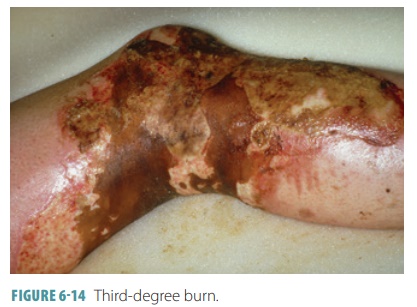Burns
| Home | | Anatomy and Physiology | | Anatomy and Physiology Health Education (APHE) |Chapter: Anatomy and Physiology for Health Professionals: Support and Movement: Integumentary System
1. Is sunburn usually an example of a first-degree, second-degree, or third-degree burn? 2. List the main causes of burns.
Burns
A burn is tissue damage caused by intense heat, chemicals, electricity, or
radiation that kills cells and denatures cell proteins. The leading causes of
accidental death are burns. They may occur because of fires, UV radiation, hot
water, spills, radiation, strong acids or bases, or electrical shock. Burns may
cause death as a result of fluid loss, infection, and the toxic effects of
burned tissue known as eschar. A
severely burned patient often dies from dehydration and electrolyte imbalance,
which lead to renal failure and circulatory shock. Immediate intravenous
infusion of lost fluids is required to save the lives of these patients.
In a burned adult, fluid loss
volume is estimated by using the rule of nines, which assesses the percentage of the overall body that has been
burned. The body is divided into 11 areas that basically each account for 9% of
the overall body area, with an additional area accounting for the genital area
(1%). TABLE 6-1 summarizes an estimation of body burns by using the rule of nines. To
allow for tissue repair and replace lost proteins, the burn patient requires
thousands of daily food calories that are in excess of normal caloric
requirements. This is provided by supplementary nutrition via intravenous and
gastric tubing. Once stabilized, the next concern is infection. Widespread
bacterial infection (sepsis) is the primary cause of death in burn victims.
Although burned skin remains sterile for 24 hours, the destroyed skin barrier can
then be easily penetrated by many different pathogens, which multiply quickly
in this nutrient-rich environment. The immune system, by this point, has also
become deficient.

Burns are classified into three
types:
■■ First-degree burns: Involve only the epidermis; sig-nified by redness, pain,
and slight edema. These burns heal quickly and usually do not leave scars. Most
sunburns are first-degree burns (FIGURE 6-12).

■■ Second-degree
(partial-thickness) burns: Involve the epidermis and dermis but leave some of
the dermis intact; they may appear red, tan, or white with blisters.
Second-degree burns are very pain-ful, are slow healing, and may leave scars.
Serious sunburns and many scaldings are second-degree burns fIGURE 6-13).

■■ Third-degree (full-thickness)
burns: The epidermis and dermis
are completely destroyed, and deeper tissue may even be damaged; the skin can
repair itself only from the edges of the wound. These burns often require skin
grafts, and if left to heal on their own may result in abnormal connective
tis-sue fibrosis and severe disfigurement (FIGURE
6-14).

Burns are considered critical if
over 25% of the body has second-degree burns, if over 10% of the body has
third-degree burns, or if there are third-degree burns on the face, hands, or
feet. A facial burn may include burning of the respiratory passageways, causing
swelling and suffocation. Burned joints of the body can result in debilitating
scar tissue, preventing mobility.
1. Is
sunburn usually an example of a first-degree, second-degree, or third-degree
burn?
2. List
the main causes of burns.
Related Topics






